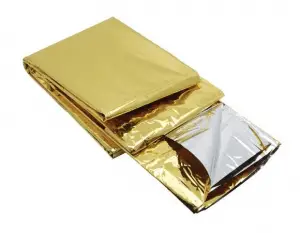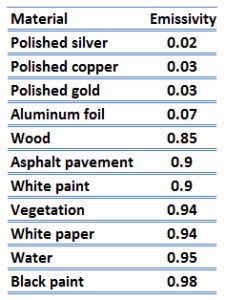Space blankets are designed to reflect heat to the body or deflect heat when used as a shelter from the sun. They can be used to insulate everything from the Mars rovers to marathon runners, satellites to sun shields, and rockets to residences.
As was written, thermal insulation is based on the use of substances with very low thermal conductivity. But sometimes, the most effective way to protect persons or devices from leakage or gain of heat is to use a thermal radiation insulator. Thermal radiation does not require any medium for energy transfer. Moreover, energy transfer by radiation is fastest (at the speed of light), and it suffers no attenuation in a vacuum.
In contrast to heat transfer by conduction or convection, which occurs in the direction of decreasing temperature, thermal radiation heat transfer can occur between two bodies separated by a medium colder than both bodies. For example, solar radiation reaches the earth’s surface after passing through cold layers of the atmosphere at high altitudes.
 Space blankets (depending on the function, also known as a Mylar blanket, emergency thermal blanket, or safety blanket) can be used to insulate thermal radiation. Space blankets were first developed by NASA in 1964. Therefore, the highly reflective insulators are often included in emergency kits (therefore, emergency thermal blankets). Long-distance runners also use them after finishing a race to avoid a large swing in body temperature. Space blankets are designed to reflect heat to the body or deflect heat when used as a shelter from the sun. They can be used to insulate everything from the Mars rovers to marathon runners, satellites to sun shields, and rockets to residences. It is one of the simplest yet most versatile spinoffs to come out of the Agency. Highly reflective foils in radiant barriers and reflective insulation systems reflect radiant heat away from persons and living spaces, making them particularly useful in very cold climates.
Space blankets (depending on the function, also known as a Mylar blanket, emergency thermal blanket, or safety blanket) can be used to insulate thermal radiation. Space blankets were first developed by NASA in 1964. Therefore, the highly reflective insulators are often included in emergency kits (therefore, emergency thermal blankets). Long-distance runners also use them after finishing a race to avoid a large swing in body temperature. Space blankets are designed to reflect heat to the body or deflect heat when used as a shelter from the sun. They can be used to insulate everything from the Mars rovers to marathon runners, satellites to sun shields, and rockets to residences. It is one of the simplest yet most versatile spinoffs to come out of the Agency. Highly reflective foils in radiant barriers and reflective insulation systems reflect radiant heat away from persons and living spaces, making them particularly useful in very cold climates.
In emergency thermal blankets, the blankets are used to prevent/counter hypothermia. Their compact size before unfurling and lightweight makes them ideal when space is at a premium. They may be included in first aid kits and also in camping equipment. Their design reduces the heat loss in a person’s body, which would otherwise occur, especially due to:
 Thermal radiation. As was written, radiation heat transfer is achieved by minimization of radiant heat transfer rate, q [W/m2], from a body to its surroundings is proportional to the fourth power of the absolute temperature. In this case, the emissivity of material also plays a very important role. The emissivity, ε, of the surface of a material is its effectiveness in emitting energy as thermal radiation and varies between 0.0 and 1.0. The surface of a blackbody emits thermal radiation at approximately 448 watts per square meter at room temperature (25 °C, 298.15 K). Real objects with emissivities less than 1.0 (e.g., aluminium foil) emit radiation at correspondingly lower rates (e.g., 448 x 0.07 = 31.4 W/m2). See also: Kirchhoff’s Law of thermal radiation
Thermal radiation. As was written, radiation heat transfer is achieved by minimization of radiant heat transfer rate, q [W/m2], from a body to its surroundings is proportional to the fourth power of the absolute temperature. In this case, the emissivity of material also plays a very important role. The emissivity, ε, of the surface of a material is its effectiveness in emitting energy as thermal radiation and varies between 0.0 and 1.0. The surface of a blackbody emits thermal radiation at approximately 448 watts per square meter at room temperature (25 °C, 298.15 K). Real objects with emissivities less than 1.0 (e.g., aluminium foil) emit radiation at correspondingly lower rates (e.g., 448 x 0.07 = 31.4 W/m2). See also: Kirchhoff’s Law of thermal radiation- Water evaporation and large-scale convection. Thermal blankets are usually made from BoPET (Biaxially-oriented polyethylene terephthalate) airtight foil, causing them waterproof and windproof. This prevents large-scale convection and heat losses caused by evaporation of perspiration.